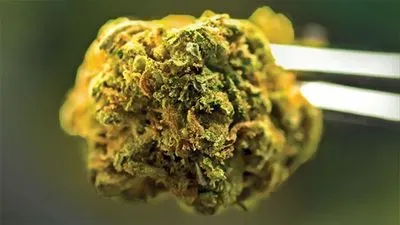In the May 20, 2016, Journal of Pharmaceutical and Biomedical Analysis, Giuseppe Cannazza, assistant professor in the life science department at the University of Modena and Reggio Emilia Via Campi (Modena, Italy), and his colleagues wrote: “In the last few years, there has been a boost in the use of cannabis-based extracts for medicinal purposes,” and they added that the “preparation procedure has not been standardized but rather decided by the individual pharmacists.”
As cannabis-based products are accepted more for medicinal and recreational uses, standardized methods of analysis must be developed, validated, and harmonized. In hopes of moving in that direction, Cannazza and his colleagues developed a high-performance liquid chromatography (HPLC) method based on UV detection. This HPLC-UV method can be used to quantify key cannabinoids of cannabis: CBD-A, CBD, CBN, THC, and THC-A.
The complexity of cannabis drives the need for advanced analysis of this product’s components. As Kymron DeCesare, chief research officer at Steep Hill Labs (Berkeley, CA), says, “There are a lot of analytical challenges in using cannabis for medical applications.” He adds, “There are no federal regulations, and that leaves labs fending for themselves.”
High-Performance Analysis
When asked why there is a need for new methods to analyze cannabis, Cannazza says, “Since there is no Pharmacopoeia monograph or standardized protocol for cannabis extracts, a recent Italian law decree has imposed the quantitative determination of the main cannabinoids in each cannabis-based galenical preparation.”
 This HPLC-QTOF 3D chromatogram of an ethanol cannabis extract indicates the chemical complexity.Image courtesy of Giuseppe Cannazza.This decree and other legal and economic drivers push scientists to find easier and more affordable ways to analyze cannabis. As Cannazza explains: “Since a mass spectrometer detector is quite expensive for a pharmacy, the main goal of our work was to develop an alternative—simple and cost-effective—but still specific and sensitive analytical method that can be easily performed by a pharmacist.”
This HPLC-QTOF 3D chromatogram of an ethanol cannabis extract indicates the chemical complexity.Image courtesy of Giuseppe Cannazza.This decree and other legal and economic drivers push scientists to find easier and more affordable ways to analyze cannabis. As Cannazza explains: “Since a mass spectrometer detector is quite expensive for a pharmacy, the main goal of our work was to develop an alternative—simple and cost-effective—but still specific and sensitive analytical method that can be easily performed by a pharmacist.”
This is not a simple process, because medical products made from natural forms of cannabis include more than 400 compounds, including cannabinoids, terpenoids, alkaloids, flavonoids, fatty acids, etc. Consequently, Cannazza states: “We have developed a cost-effective chromatographic method coupled to a UV detector (HPLC-UV) and compared the qualitative and quantitative results with those obtained with an expensive high-resolution mass spectrometry detector—HPLC-QTOF.” He also says that “the results obtained indicate that the HPLC-UV method is sensitive and selective enough for the determination of the main cannabinoids in galenical preparations, and [because of] its simplicity and inexpensiveness, can be employed in the pharmacy.”
Ultrasonic Extraction
To analyze a sample, extraction is often required. “In analysis and quality control, the THC content is analyzed for quality control of recreational THC products, for quality determination of pharmaceutical THC products, or for the distinction of drug-hemp and fiber-hemp,” explains Kathrin Hielscher, marketing manager at Hielscher Ultrasonics (Teltow, Germany). “The ultrasonic sample preparation is used to release the targeted substances before chromatography.” Traditionally, the analysis includes thin-layer chromatography (TLC), gas chromatography (GC), or HPLC.
The ultrasonic preparation method provides several benefits. “Sonication applies intense shear forces and stress to the medium and, thereby, releases high extract yields in a very short time,” Hielscher explains. “This means that the extraction process of active substances, such as cannabinoids and terpenes, from the cannabis plant is substantially increased.” Thus this extraction method is fast and efficient. It also collects more of the substances in their natural forms. “As a nonthermal extraction method, sonication is gentle and mild so that the extracts are not degraded or damaged,” Hielscher says.
Lab Quality Management Certificate
The Lab Quality Management certificate is more than training—it’s a professional advantage.
Gain critical skills and IACET-approved CEUs that make a measurable difference.
This form of extraction can also be customized by using it with various solvents, including waterand oil-based ones, as well as others. The ultimate application of the product can determine the best solvent to use in an extraction. For example, if a cannabis-derived product will be inhaled, some of the most common solvents are butane, carbon dioxide, and propane; in preparing a product for oral ingestion, typical solvents include coconut oil, cyclohexane, ethanol, isopropanol, and olive oil.
This technology can be incorporated at many levels of research and development, as well as in manufacturing. Sonication “can be easily integrated into existing extraction setups to improve the yield and rate,” Hielscher says. Her company also offers “suitable extraction equipment for a small- or midscale extractor, a pilot, or an industrial system.”
Rooting for Regulation
As cannabis evolves into a medicinal and legal recreational industry, customers need more assurances about what they are getting and using. For example, it’s “critically important to do biological testing to keep out mold infections,” says DeCesare.
 Cannabis contains a wide range of chemicals that can be difficult to quantifyImage courtesy of the U.S. Drug Enforcement Agency.Beyond knowing that a product is safe, it should also be analyzed for what’s in it. “The drug market needs to test all of the analytes,” DeCesare says, “not just the THC, but others.” He adds, “There needs to be more restrictions on what you can put in it.”
Cannabis contains a wide range of chemicals that can be difficult to quantifyImage courtesy of the U.S. Drug Enforcement Agency.Beyond knowing that a product is safe, it should also be analyzed for what’s in it. “The drug market needs to test all of the analytes,” DeCesare says, “not just the THC, but others.” He adds, “There needs to be more restrictions on what you can put in it.”
To improve the quality of cannabis-based products, scientists and manufacturers must educate customers, DeCesare tells us. “People do die from contaminated cannabis,” he says. To prevent mold contamination, he says, “Processors must do moisture tests, so they can get control of moisture and fungus.” It takes less than a minute to perform a moisture test with Steep Hill’s QuantaCann2, which uses near-infrared spectroscopy.
For now, customers cannot rely on government regulations to ensure proper analysis of cannabis-based products. “The patients need to be their own best advocates,” says DeCesare. “Always ask for the safety reports at a dispensary.”
This combination of customer knowledge and advancing analytical methods will increase the safety of products from this industry. The expanding user base requires that assurance.
The History of Cannabis2900 BC—Chinese Emperor Fu Hsi, a fictional emperor whom the Chinese credit with bringing civilization to China, references ma—or cannabis—as a popular medicine, which possessed both yin and yang. 1611-1762—The Jamestown settlers brought the cannabis plant—commonly known as hemp— to North America in 1611. Throughout the colonial period, hemp fiber was an important export. 1850—By 1850, cannabis had made its way into the United States Pharmacopeia, which listed it as treatment for numerous afflictions, including neuralgia, tetanus, typhus, cholera, rabies, dysentery, and many more. 1936—Reefer Madness, which began as a cautionary film funded by a small church group and entitled Tell Your Children, is created. Originally intended to be shown to parents as a tale of morality about the dangers of cannabis use, it was picked up by producer Dwain Esper who re-cut the film for distribution on the exploitation film circuit. 1942—In the midst of laws and policies being enacted against the growth and usage of cannabis in the 1900’s (the first state to outlaw it—Massachusetts—did so in 1911), the United States Pharmacopeial Convention removed cannabis from the pharmacopeia. 1990—Miles Herkenham, senior investigator at the National Institute of Mental Health, and his research team discover the cannabinoid receptor system in 1990. The discovery helps scientists understand the pharmacological effects of cannabinoids, which occur when the THC in cannabis binds with the cannabinoid receptors in the brain. NOVEMBER 5, 1996—California passes Proposition 215, a state medical cannabis initiative. This permits patients and their primary caregivers—with a physician’s recommendation—to possess and cultivate cannabis for the treatment of AIDS, cancer, muscular spasticity, migraines, and several other disorders. NOVEMBER 6, 2012—Colorado Amendment 64 and Washington Initiative 502 are passed, making them the first states to legalize cannabis for personal use, commercial manufacturing, and sale in a manner similar to alcohol. JUNE 22, 2015—The U.S. federal government removes the public health review process—a long-standing bureaucratic obstacle to privately-funded medical cannabis research. In doing so, the process for application and approval for Cannabis research becomes much more streamlined. AUGUST 11, 2016—The DEA denies two petitions to reschedule cannabis under the Controlled Substances Act, but announces a policy change to expand the number of DEA-registered cannabis manufacturers. This allows researchers a more varied and robust supply of cannabis. |











